Nanachōme Kyōboshi (七丁目京星) is a small, family-run tempura restaurant in Ginza, Tokyo, and the recipient of three Michelin stars (2011, 2012, and 2013). But that's not what caught our eye. The most interesting thing to us was that the average customer pays ¥40,000 (that's approximately $400) per person.
Online, people cried foul: "It's got to be overrated!" or "It's too expensive!" Reading that, we decided to bear the burden for you, dear reader. We would go eat this $400 tempura and tell you whether or not it's actually worth that amount. Such first world problems.
But first, a quick history of Nanachōme Kyōboshi, where it came from and how it got its style and name.
Nanachōme Kyōboshi History
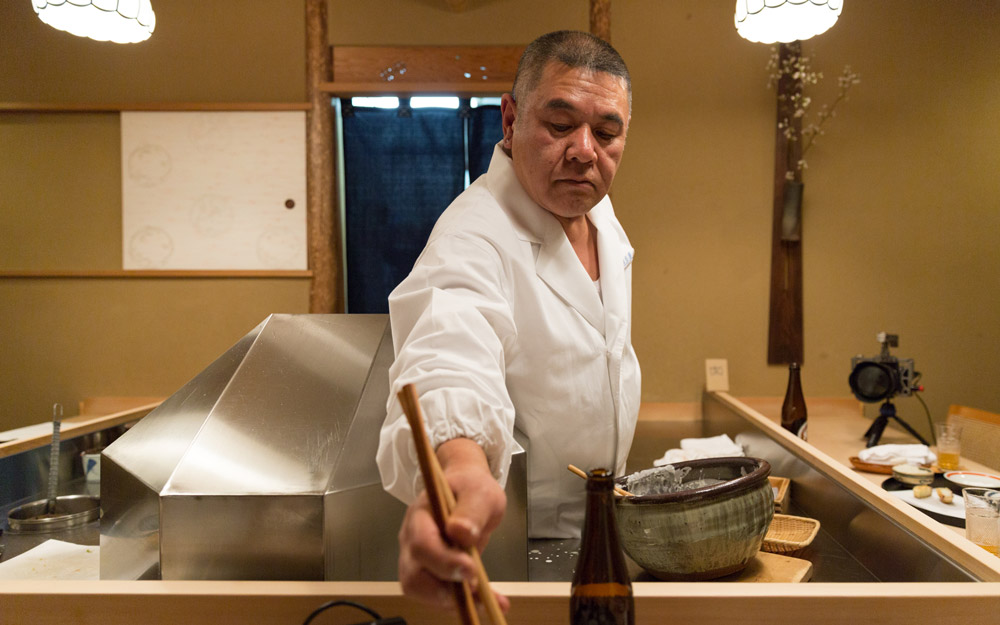
To trace the origin, we have to go back nearly 100 years to the year 1927, when a Japanese woman named Kainuma Umeko (貝沼梅子) started a Japanese restaurant called Myōjō (明星) in the Korean capital, which was called Keijō (京城) during the Japanese occupation—today we know it as Seoul. This is important later on.
His tempura earned a following, including well-known Japanese singer Misora Hibari and author Funahashi Seiichi, who wrote about the restaurant in a novel.
Fast forward to 1944. Kainuma left Korea and started another tempura restaurant in Gion, Kyoto, along with her niece, Sakakibara Shigeko, and her niece's husband. The Sakakibara family ended up having eight children, with the first son, Yoshimatsu, eventually taking over the business.
He established the foundation for the bō-age (棒揚げ) style of tempura, which is known for using fresh, seasonal ingredients, eggless batter that doesn't mask its taste, and less oil. The result is a light coating that brings out the ingredients' flavors and doesn't upset your stomach. I'm looking at you, Japanese restaurants in North America.
Yoshimatsu was the first person to prepare tempura this way and he also broke with tradition by seasoning with salt and lemon juice. His tempura earned a following, including well-known Japanese singer Misora Hibari and author Funahashi Seiichi, who wrote about the restaurant in a novel.
With all this success, Yoshimatsu wanted the challenge of a more competitive food-mosphere, so he moved to Ginza 8-chōme, Tokyo in 1952. When he did this, he changed the name of the restaurant to Kyōboshi (京星), taking one kanji from 京城 (Keijo, a.k.a. Seoul, Korea) and 明星 (Myojo, the original restaurant's name).
His tempura shop became quite popular, especially amongst the business and political bigwigs of Tokyo. During this time, his younger brothers Jūzō (child number five) and Shigeya (the youngest) learned how to make Kyōboshi bō-age tempura. This resulted in them opening a branch of Kyōboshi, Ginza 7-chōme Kyōboshi, in 1982. At some point, Shigeya became the owner and in 1998, the restaurant was moved to the 6-chōme district of Ginza, then again in 2007 to 5-chōme. Despite the moves, they kept the 7-chōme name throughout.
This is the restaurant we went to and Shigeya-san was the one who made us tempura that night. He runs it with his wife and one daughter. Unfortunately, that means the restaurant will probably end with him. He said the special technique for making this kind of tempura is only passed down to sons in the family, which was disappointing to hear, especially considering this all started with a woman in the first place. It is what it is, though. If you want to eat this magic tempura, do it before Shigeya stops making it.
What Does 3-Michelin Star, $400 Tempura Taste Like?
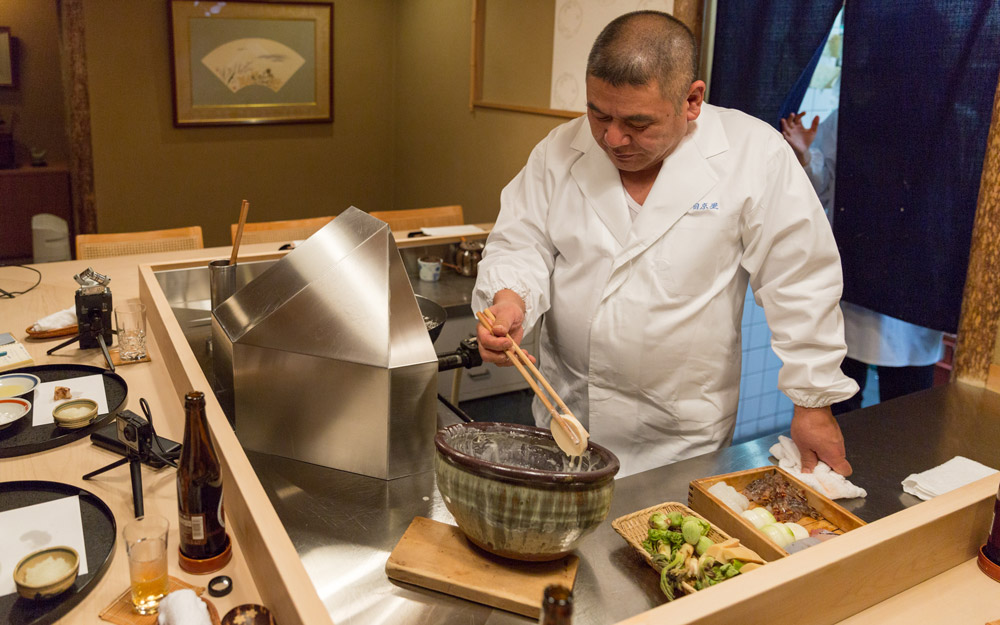
Our reservation was at 6:00 p.m. so we arrived a little before that. It was myself, Koichi, Viet, Sean, and Shin-chan, someone Koichi knew who we invited last minute when my friend flaked. (How can you miss this?)
We walked from nearby Ginza Station, found the building, and laughed a bit when we found the sign. There he was, the Michelin Man!
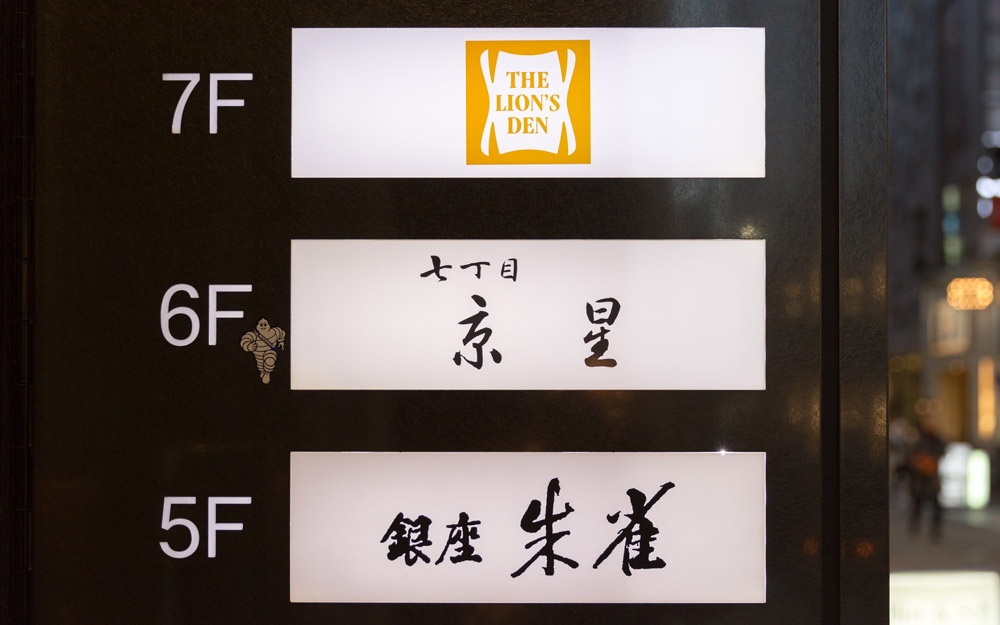
Going up the elevator, our heads were overflowing with questions. Can a tempura meal really be worth $400? Will it be worth our visit? Isn't this just the Japanese version of charging $400 for fancy fried chicken?
When the elevator door opened, we were welcomed by the daughter of the chef, as well as the chef's wife. Starting with drink orders, Shin-chan and I got water. The others ordered bottles of beer, which were ¥720 each. We thought this was a reasonable price considering how fancy the restaurant was. Previously we had read some reviews of people complaining about drink prices, so make sure you ask the price of the drink beforehand.
Champagne starts at ¥25,000 (~$250 USD) and the Chablis white wine is ¥16,000 (~$160 USD). Other than drinks, though, you'll never need to worry about what to get. There's one food option and that's the tempura course, which runs you ¥38,000, per person, plus tax (as of March 2016).
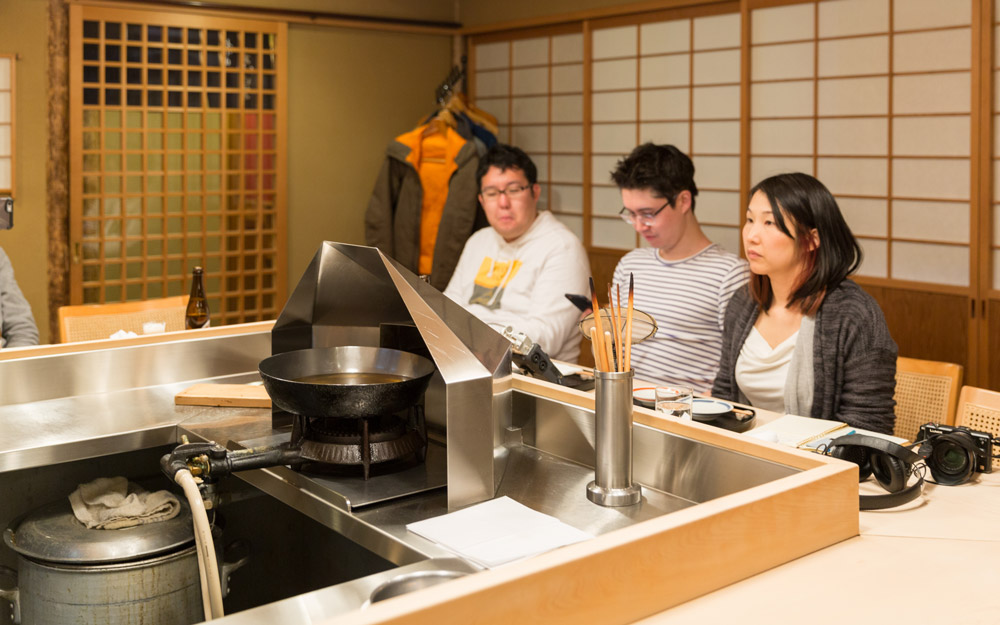
After getting our drinks, the magic began. What was at first a feeling of apprehension around the price became a feeling of excitement. This happened with our appetizers, takenokonokino meae 竹の子の木の芽和え, bamboo shoots dressed with white miso and sanshō pepper leaf buds, and ankimo あん肝, monkfish liver, a.k.a. foie gras of the sea. Both had strong, fresh flavors and with that, we were already sold.
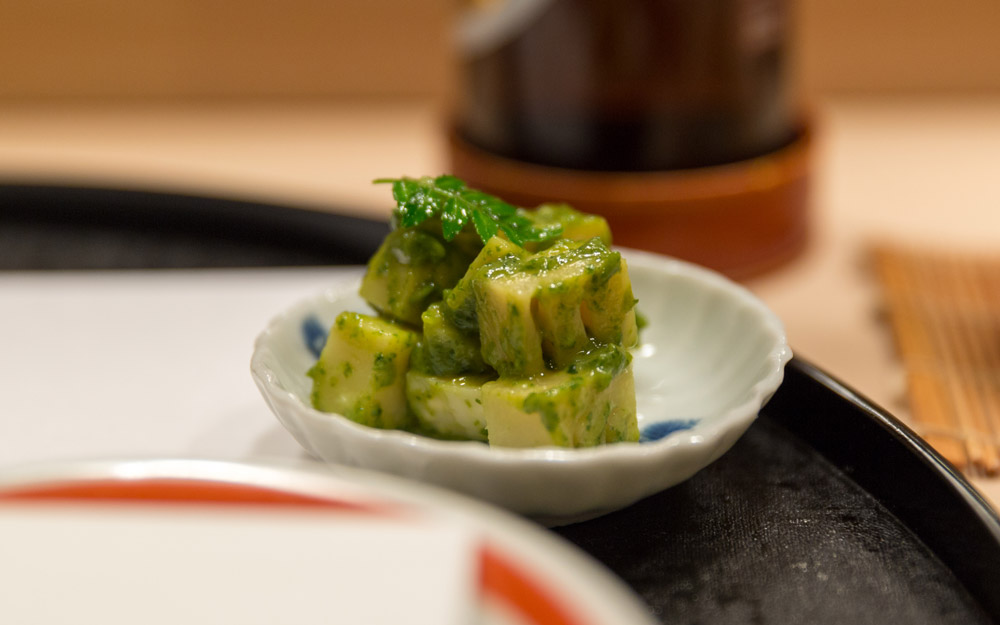
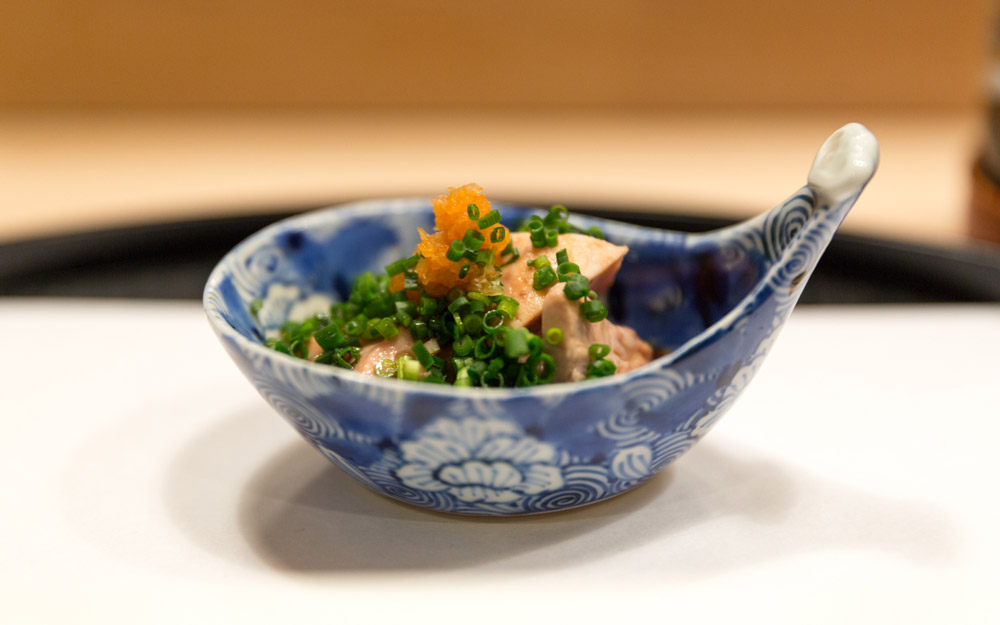
We asked him how he felt when he lost Michelin stars and he told us that it was actually he who decided to be de-listed from Michelin, but the reason was a secret.
After eating the appetizers, Sakakibara showed up to cook the tempura. Surprisingly, he greeted the US crew in English and said he speaks English as well as a few other languages. He memorized greetings and explanations of the foods for customers in several languages. How nice!
The deep-fryer for the tempura was built inside the counter, so customers can both watch him cook and talk with him while eating. He looked kinda scary when he first got there, but we soon found out how kind he actually is—the first hint being how promptly he offered us his cute smile.
He didn't talk much and when we asked questions, there were a lot of things that he wanted kept secret. For example, we asked him how he felt when he lost his Michelin stars and he told us that it was actually he who decided to be de-listed from Michelin, but the reason was a secret.
The style of not talking a great deal or not divulging secrets is very Japanese craftsman-like. I suppose it's just as the saying goes: shokunin wa ooku o katarazu 職人は多くを語らず, meaning "craftsmen don't talk a lot."
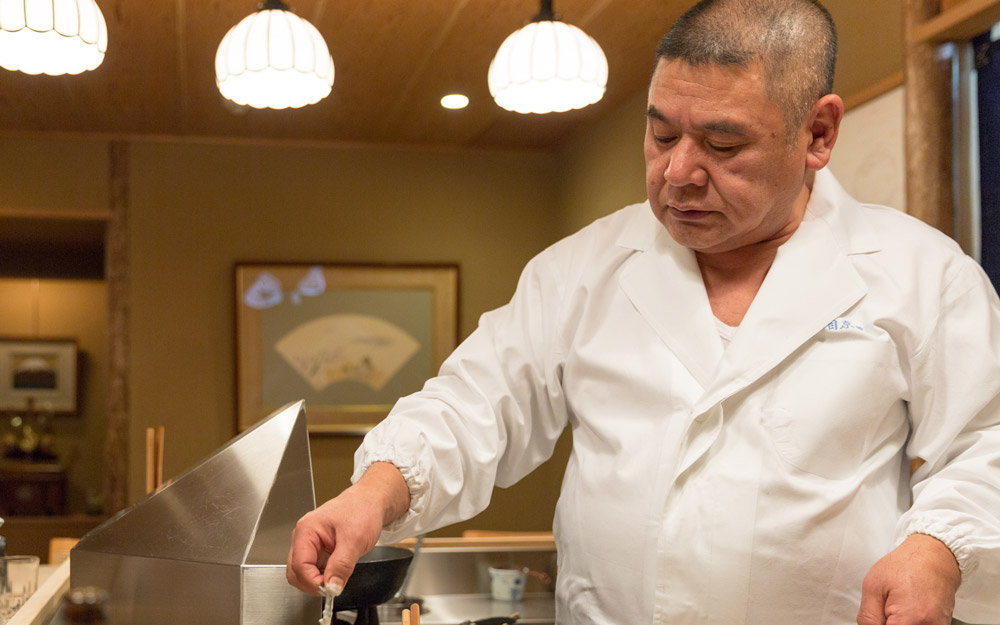
Since Chef Sakakibara does tempura in the bō-age style, there is no sauce to dip into. Instead, he put some finely powdered homemade salt on each of our plates. On another plate, he poured lemon juice and on yet another he put grated daikon. Whenever either of these got low, he filled it up.
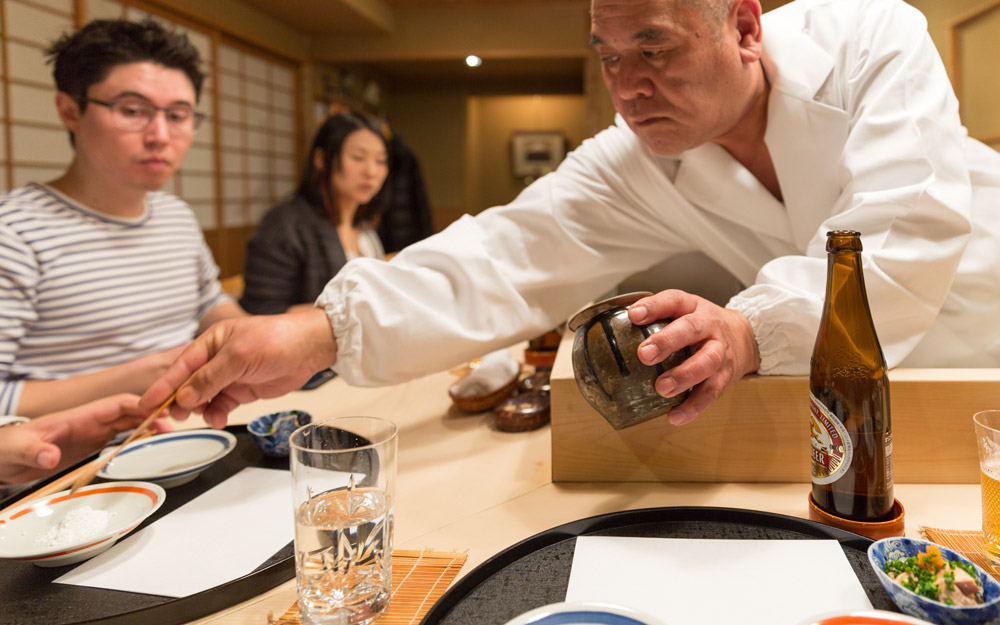
The salt was a surprise to all of us. First, it was light and each grain of salt was so, so tiny. It was like a fine, salty snow powder on all of our plates. The taste was unique too. Perhaps it was just how finely ground it was. Koichi theorized there was some cocaine in there, due to the sexy fever dreams he had about the salt during the following weeks. It was that good.
We asked him why it was so good. But of course, he responded with, "It's a secret." He told us that people who can't make salt like this tend to add matcha, pepper, or shichimi spice to make the taste unique. So he's making this special salt somehow! That means, if you want to try it, you have to come here and nowhere else!
Let the Tempura Feast Begin

The first tempura served was ebi sandoicchi 海老のサンドイッチ, which means "shrimp sandwich." It consisted of minced shrimp between two thin slices of toast which were then deep fried. A deep fried sandwich sounds like it would be heavy, but it was extremely light. The texture of the crisp-yet-soft toast, combined with the shrimp, complemented each other well and had a fresh shrimp flavor. This is what they're talking about when they say "tempura should bring out the natural flavors of the ingredients."
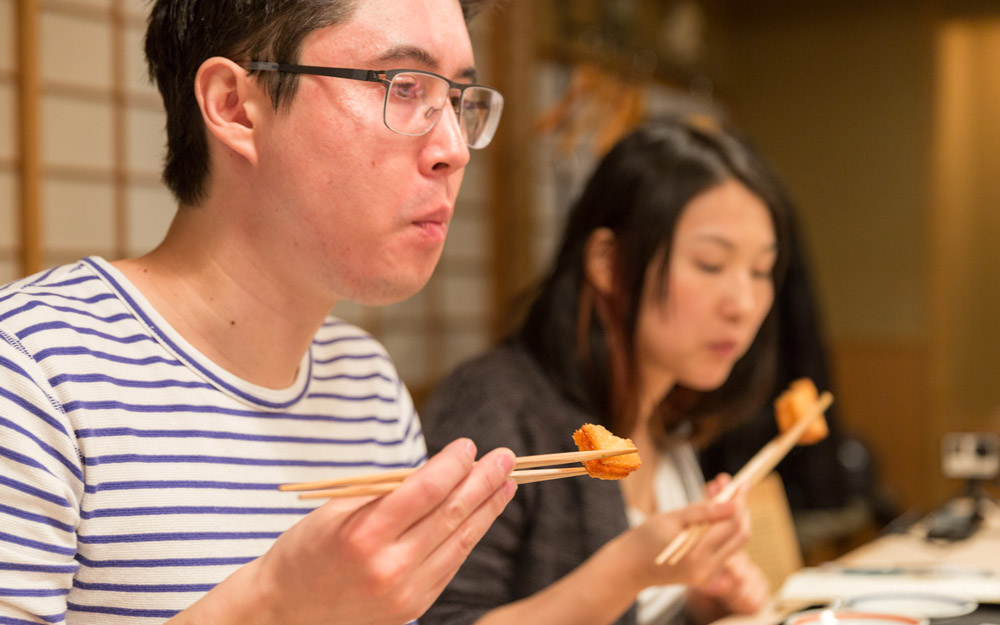
We wondered if the taste and lightness came from the oil, so we asked about that too. Of course, it was another one of Kyōboshi's secrets. The most he'd say is that his oils are actually a combination of four different oils. When Koichi asked if they were vegetarian oils, he again said it was a secret. I can tell you one thing though: I'm pretty sure sesame oil was not one of the four used. One oil down, all other oils left to go.

The second tempura served was their signature saimaki shrimp tempura. It was a tiny, pinky sized shrimp tempura and at first we were surprised with how small it was. But there was just enough of it to enjoy the texture and sweetness of the shrimp.
Sakakibara-san specifically told us to make sure we ate the entire tempura, including the tail. We ate it with salt and lemon and it ended up being the sweetest shrimp I've ever tasted. On top of this, the shrimp flavor was strong, but at the same time not overly "shrimpy."
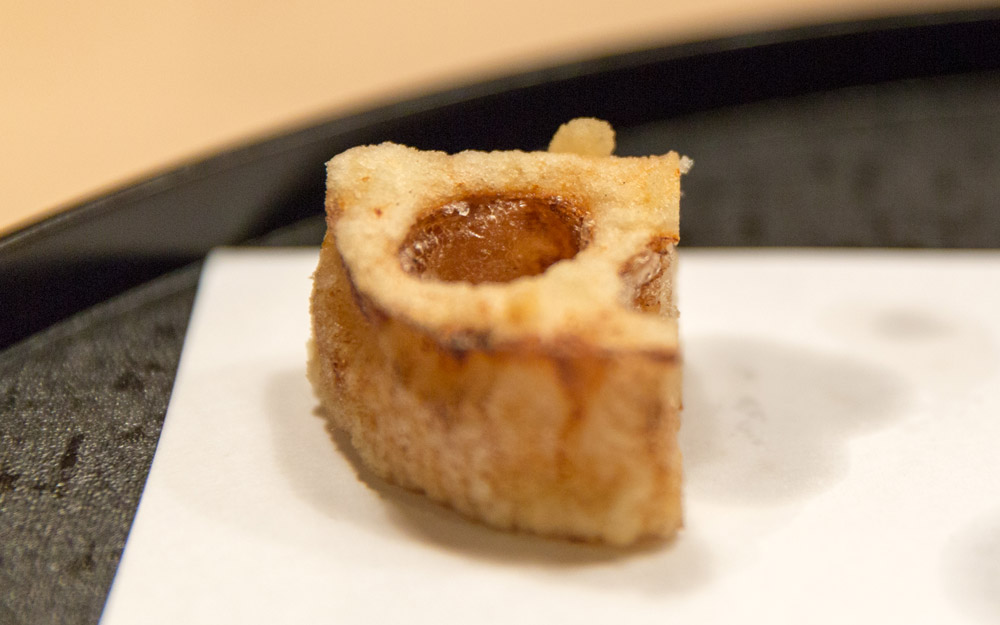
Now the tempura was coming out in quick succession, just as we were finishing our previous batch. The third tempura was renkon 蓮根 (lotus root) cut into chunks the size of quarters. Biting into it, it was surprisingly soft. I asked him if he boiled it first, but he said he just deep fries the raw lotus root. The sweetness of the lotus root really comes out with this method. This is remarkable because lotus root isn't particularly known for its sweetness.
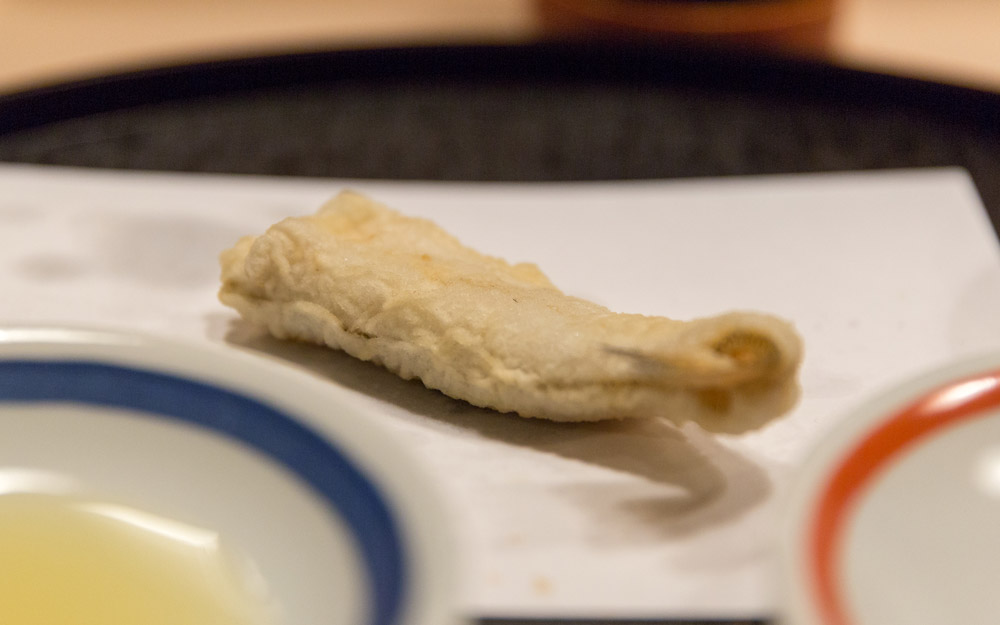
"I look around at what they have there and if I find something good, I just buy it and use it for the course. So what the course will be on any given day depends on what was in the market that morning."
—Chef Sakakibara
Our fourth tempura was kisu キス (sand borer fish). We were told to eat it with lemon and a bit of salt. Two of these small fish were put together and deep fried. It was hot but tasty. The chef told us to eat some of the grated daikon if temperatures got too high. Koichi tried this technique out because he tried to eat his too quickly and he said it worked.
After seeing so many different types of tempura go by, with each individual ingredient cooked one by one, so carefully, I asked if he had a specific amount of time for deep frying each ingredient. His answer was simply, "No, I've been doing this so long that I don't think about things like that very much. I just do it freehand." With so many years of practice, I definitely believe him, though this may also just be another way of him saying it's another one of his secrets.
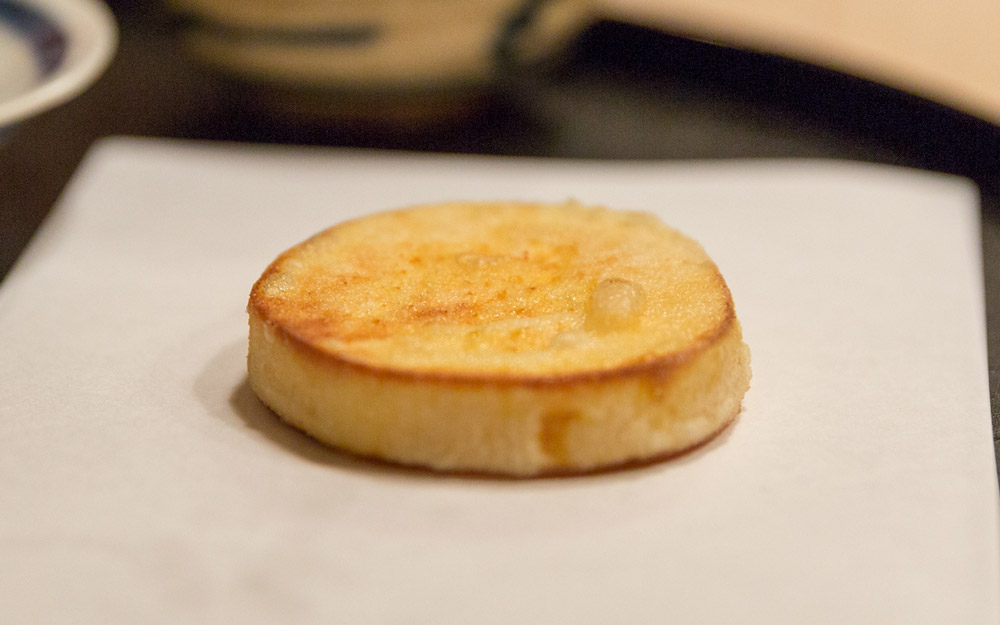
Our fifth tempura was sweet potato. He used a type called anno imo アンノイモ, which is an ancestral species of the Japanese sweet potato. He told us that vegetable tempura is usually good with salt, but there are no rules, so we could eat them however we liked after this.
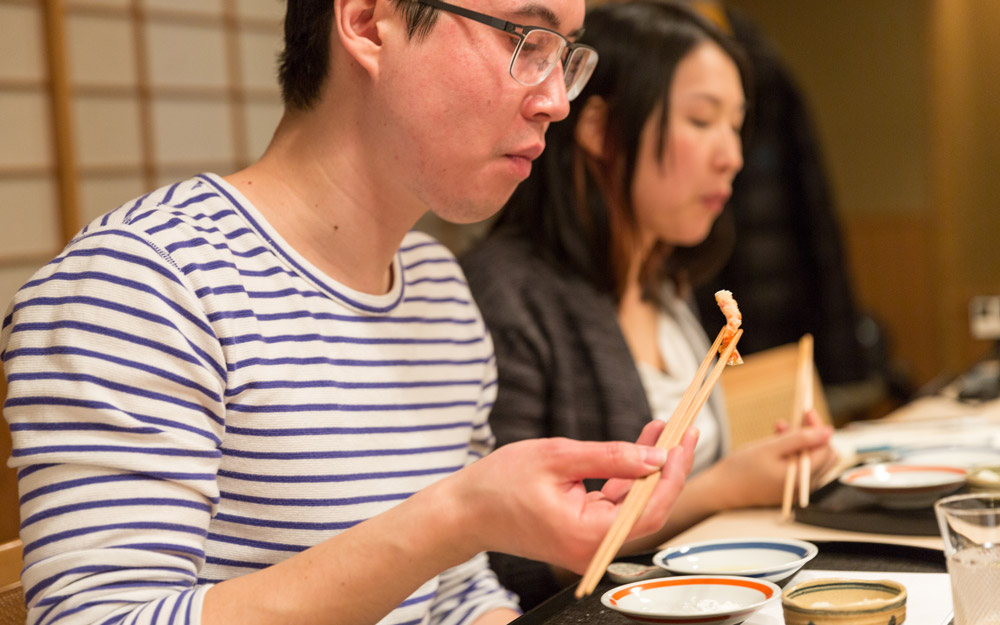
The sixth tempura was the sweet tiny shrimp again. Although a lot of questions were answered with "it's a secret," we weren't afraid to keep asking. "Where do you buy all your ingredients?" This time, he didn't use his go-to answer.
"Basically all the ingredients come from Tsukiji market. My morning starts pretty late, though. I go to Tsukiji around 9:00 a.m. I don't choose the shrimp myself. A shrimp shop does it for me every day. I just tell them the size of shrimp I want and they collect similarly sized ones on a consistent basis. I have professionals pick almost all of the other fish for me too, so I basically just go there each day to pick it all up and pay for it. That's why I don't have to go early. As for vegetables, I also buy them at the Tsukiji market and I look around at what they have there and if I find something good, I just buy it and use it for the course. So what the course will be on any given day depends on what was in the market that morning."
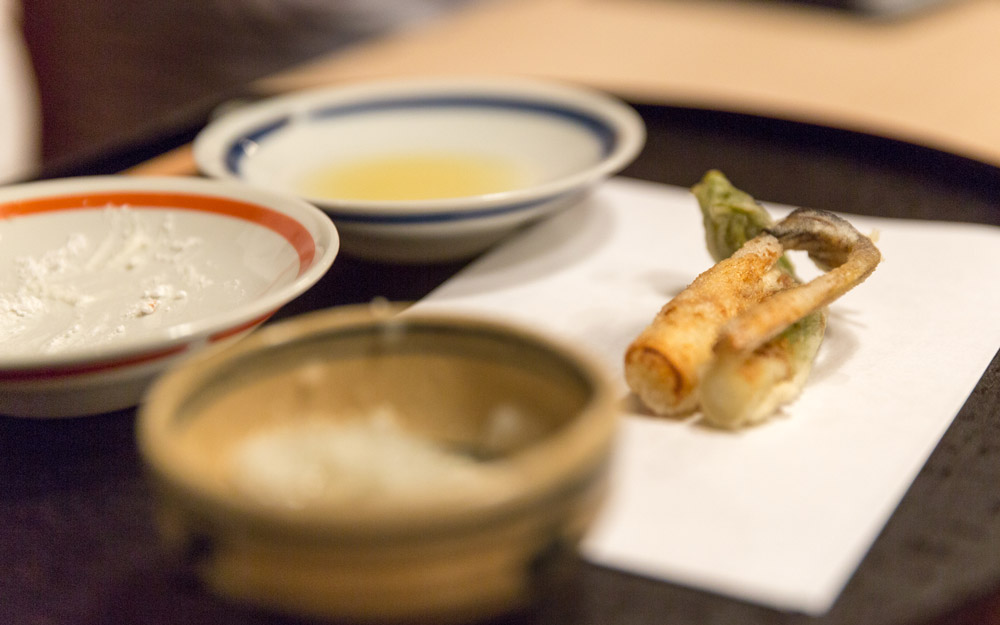
His statement about ingredients rang true with the seventh dish: a wild spring plant called udonome うどの芽 or udonoshinme うどの新芽, which can be translated to "Udo bud/sprout."
It had a nice bitterness and unique Japanese spring freshness to it. In this season, when the snow melts, these wild plants, called sansai, are foraged in wooded areas and for a short while Japanese people can enjoy this particular joy of the new season. The sound of it deep frying was enjoyable for me too. The anticipation of seeing what popped out from behind the counter was exciting every time and I certainly didn't expect this! Koichi, who tends to like more bitter foods, said this was probably his favorite, aside from the dessert.
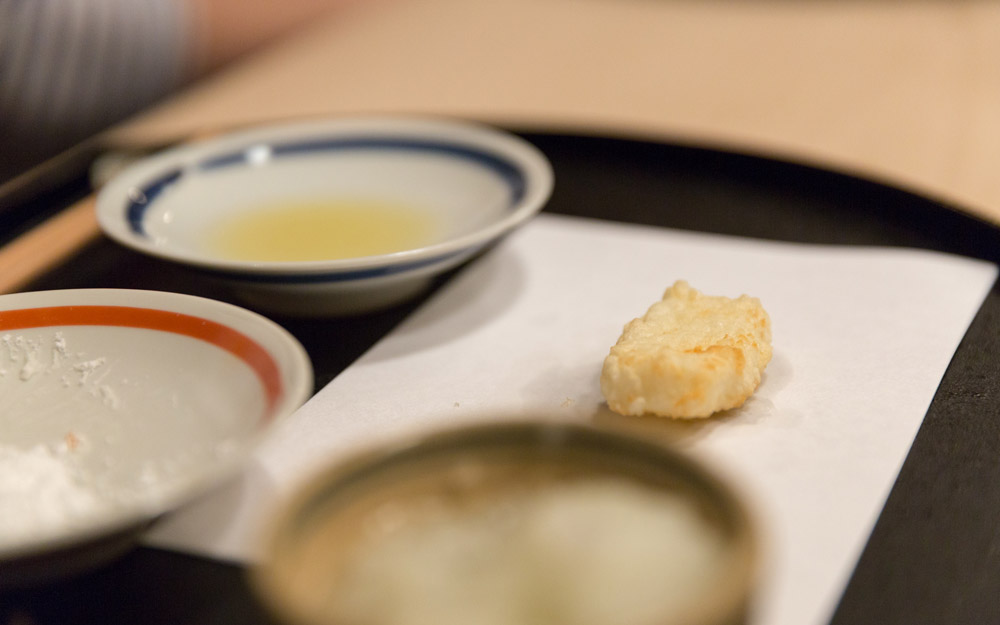
The eighth tempura was aori ika 障泥烏賊, which is often translated to "big fin reef squid," "oval squid," or "the king of squid." It was soft, but still had some chewy consistency to the meat, as it was quite thick. However, after just a few chews, it melted in our mouths and the sweet flavor of it spread over our tongues. The consistency and flavors were impressive.
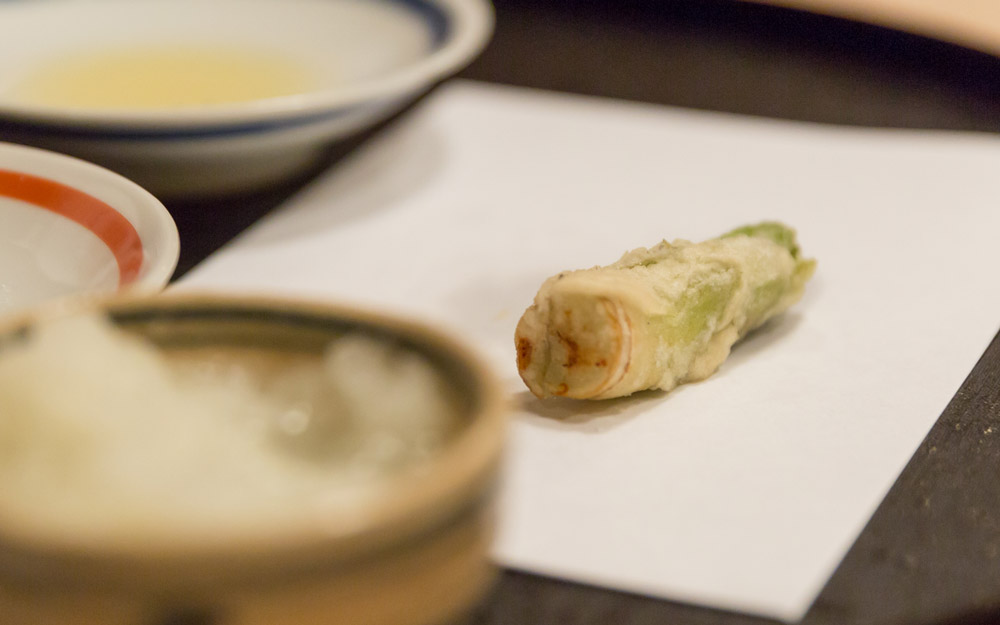
The ninth tempura (you should buckle in, because we're only like halfway done) was karanome タラの芽, which is "aralia sprout" in English. Just like the Udo sprout served earlier, this is also a wild plant that arrives during those first few breaths of spring. Its buds appear right around the same time as cherry blossoms, in fact.
Once again, we ate this with lemon and salt (because, like Koichi said, the salt was probably laced with crack, cocaine, or crack cocaine). Like the Udo sprout, it had a delicate bitterness and the aroma was strong but pleasant. You may think it's odd for me to continually praise the bitterness of things like this, but if the sprout is too young, the bitterness is too faint, and if the sprout is too old, it's too bitter. This sprout had the perfect balance, which was then enhanced by the lemon and salt. It's difficult for me to explain how well-prepared these dishes were if you haven't had these kinds of plants before. It was just really, really good.
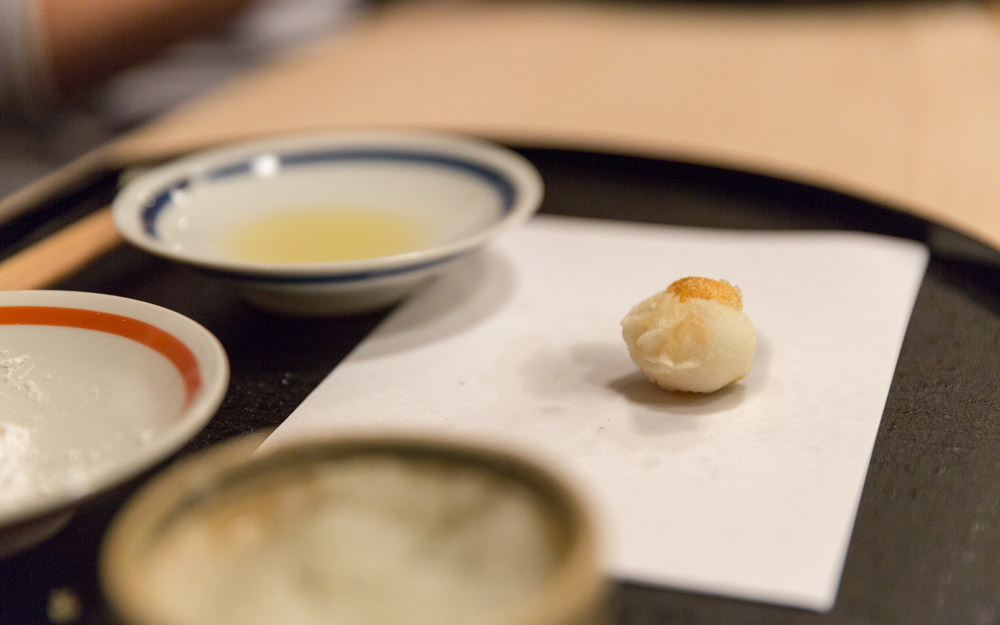
The tenth tempura was uzurano tamago うずらの卵 (quail egg). The chef instructed us to eat it in one bite. He didn't tell us the reason when he told us, but it was because the egg was soft boiled, so it melted onto our tongues after the tempura batter shell was broken.
Compared to other quail eggs, this one had an elegant flavor. Rich and fresh, all of these sensations exploded in our mouths.
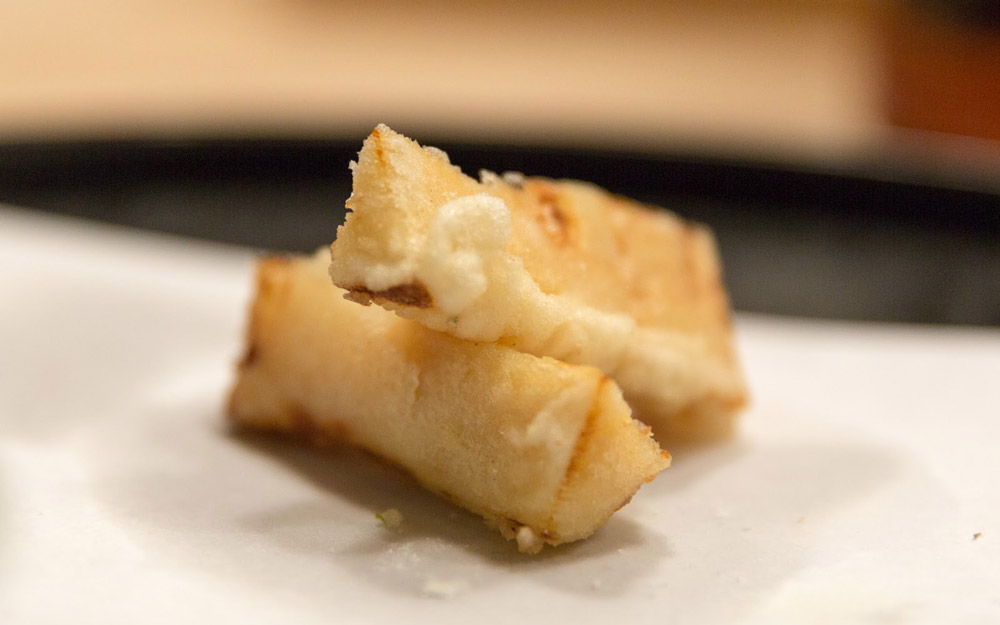
The eleventh tempura was takenoko 竹の子, bamboo shoot. It took a bit longer than the others to cook. The owner left to go into the kitchen and came back when it was perfect.
I grilled him more on his cooking methods, asking if he perhaps uses the sound of the oil to determine when something is done. He replied saying it wasn't that, he just knows the timing from lots of experience.
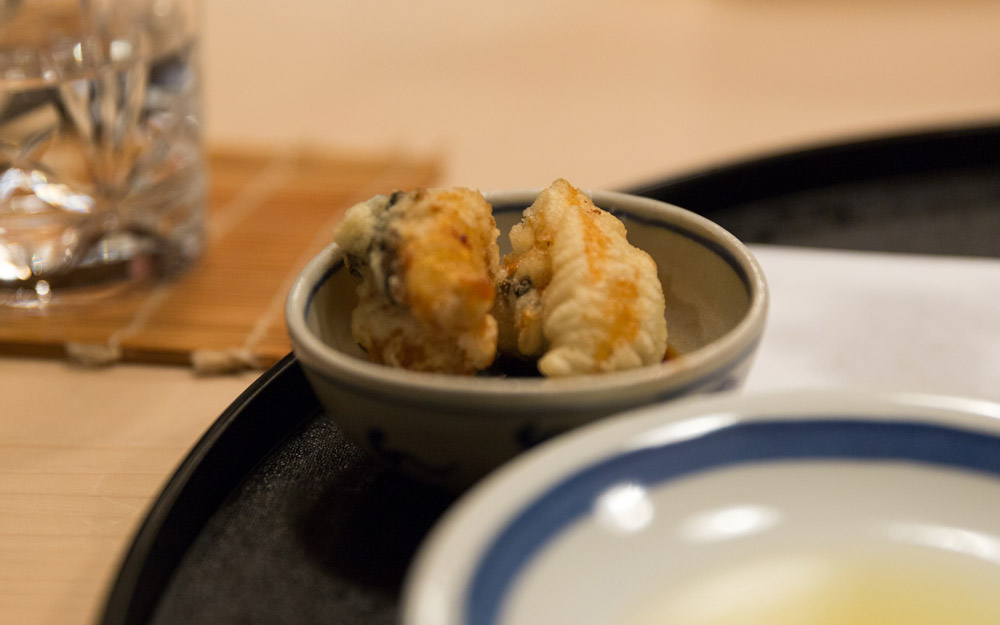
Because the quail egg was soft boiled, it all just melted on our tongues after breaking the tempura batter shell.
The twelfth tempura was okoze おこぜ (stone fish). It's considered one of the highest grades of fish, due to its elegant, white meat. We ate this one with a special ponzu sauce, which brought out the vibrancy of the flavors.
When you think of dangerous fish in Japan, you probably immediately think of blowfish and its paralyzing tetrodotoxin. But did you know the stone fish is the most venomous fish in the world? Despite this, you never hear about people dying from eating it. And neither did we! It may be a terrifying poison-monster under the sea, but on land it's simply delicious. Somehow, Nanachōme Kyōboshi has made it even better.
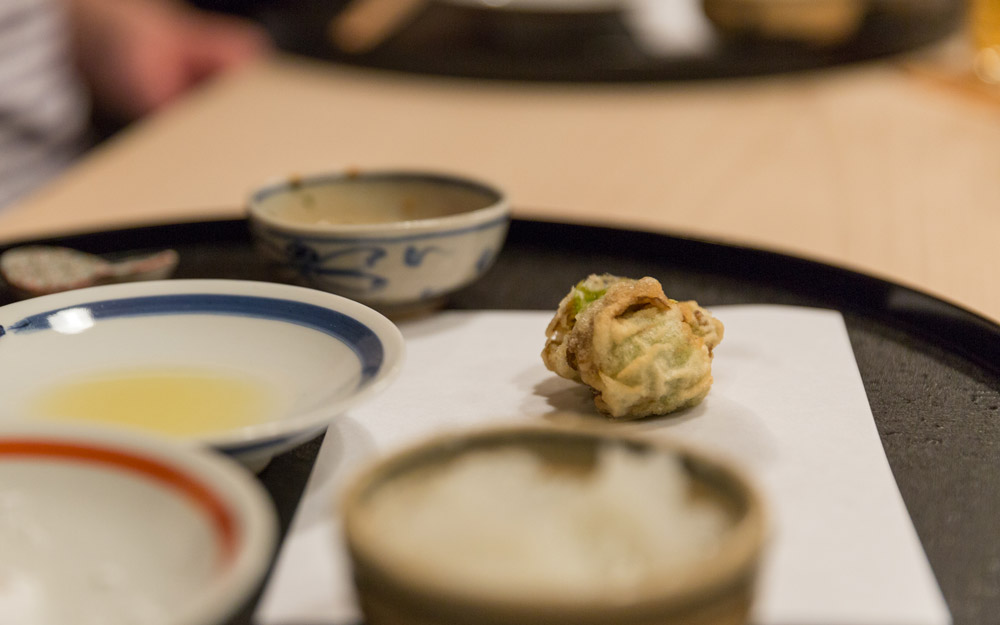
Number thirteen was fukinotou ふきのとう (butterbur scape). This is another wild plant that is part of the "joy of spring" family. It also has a nice bitterness and fresh aroma. Interestingly, this also happens to be the main component for the medicine Ryukakusan (Dragon Diffusion), which I had been taking during this trip. I was informed that it would help with my persistent cough. It didn't work very well, but the tempura was great.
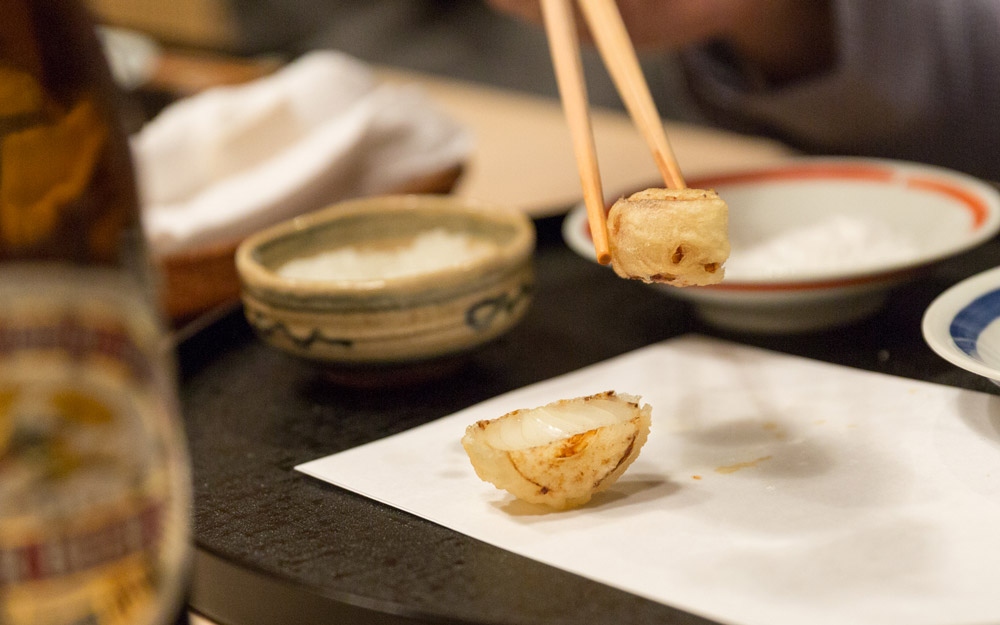
Numero fourteen was a small tamanegi 玉ねぎ (onion). It was soft, sweet, and had a lot of concentrated onion flavor. Despite being so small, I thought the portion was just right. Two bites of onion is plenty, even if it is sweet.
Tempura fifteen was kobashira 小柱, which are known as "small scallops" or "short-necked clam addoctors." It was hot, sweet, flavorful, and had a lovely crunch. コリコリ is what we'd say in Japanese. It's too bad, though, because it seems like we enjoyed it so much that we forgot to take a photo.
So, it's on to the next dish we go. Sorry about that.
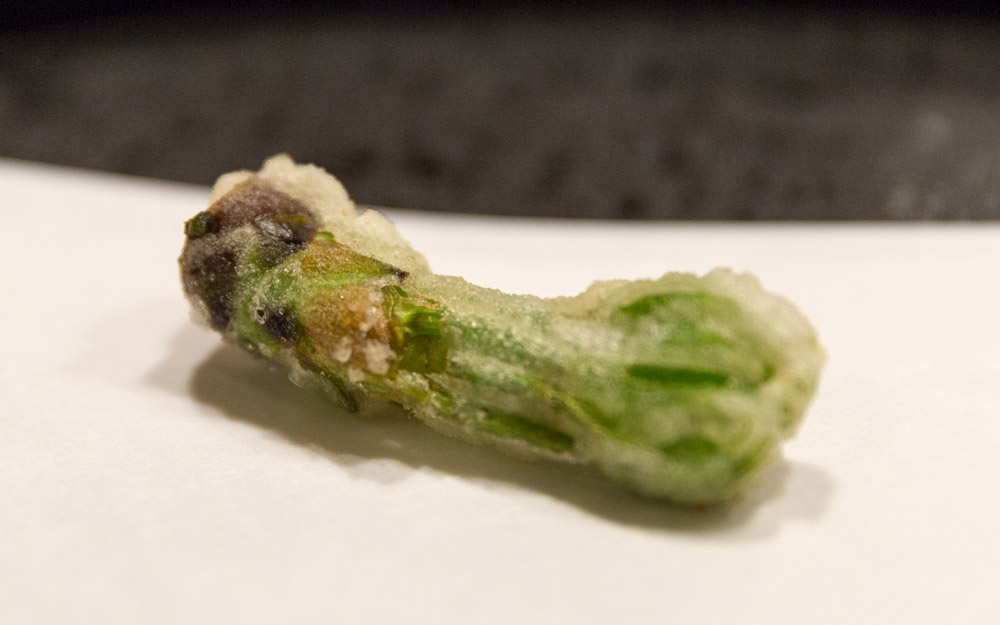
Tempura sixteen was koshiabura コシアブラ, yet another wild, edible plant. All the vegetables we ate had an element of bitterness, which was both distinct but also pleasant. The koshiabura was no exception.
Because of bitter vegetables, I would say Kyōboshi is definitely more geared toward adults. Don't bring your kids, because they'd probably be just as happy with a $5 meal at McDonalds. Still, if you have a fancy boy or girl, Nanachōme Kyōboshi will let them in as long as they're ten years of age or older.
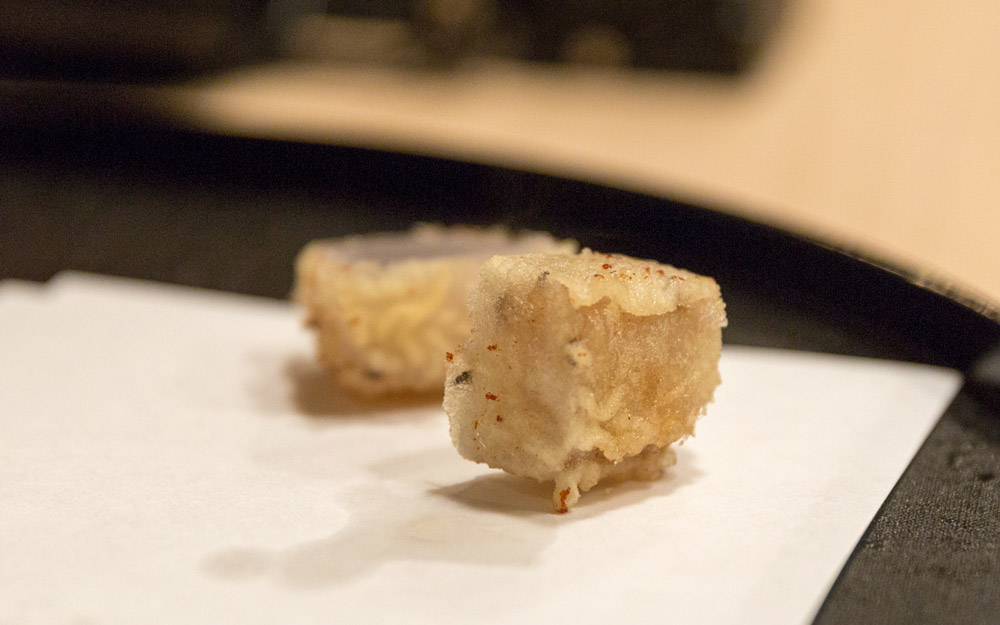
Okay, almost there! Number seventeen was Kyoto's own kenjōkonnyaku 献上蒟蒻, a hard jelly made from the starch of devil's tongue (konnyaku). Fun fact, the emperor loves to eat this stuff. Also, it doesn't contain calories. Thank the gods for deep frying!
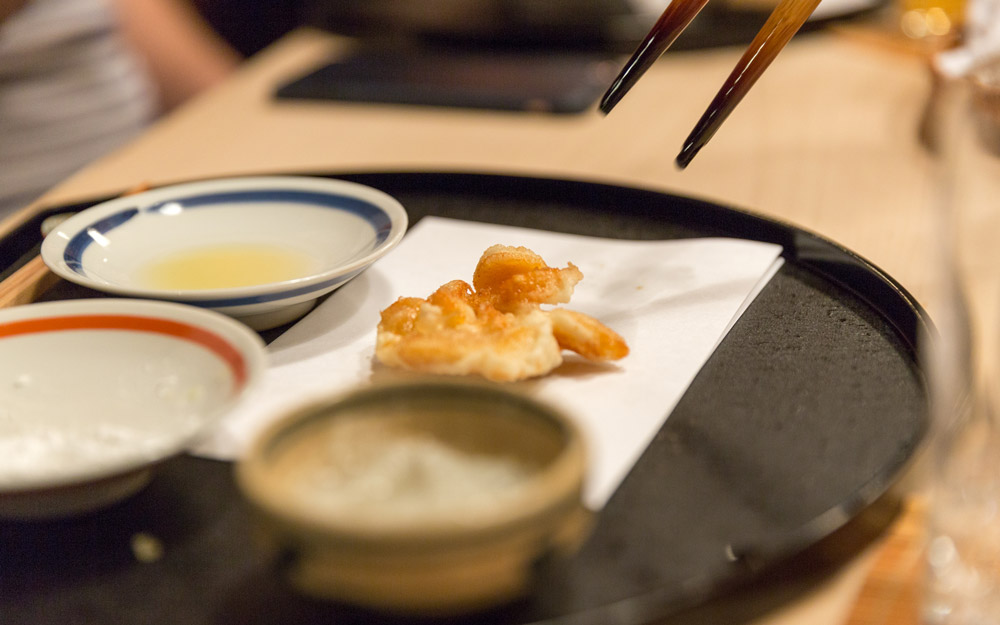
Although I sorted these photos of the tempura in order, we were definitely given more than two shrimp. I would guess each person got 3–5 shrimp, at least. Chef Sakakibara would use them to cleanse your palate and generally served us in vegetable, seafood, vegetable, seafood order. So we probably got shrimp whenever there were two vegetable tempura listed in a row.
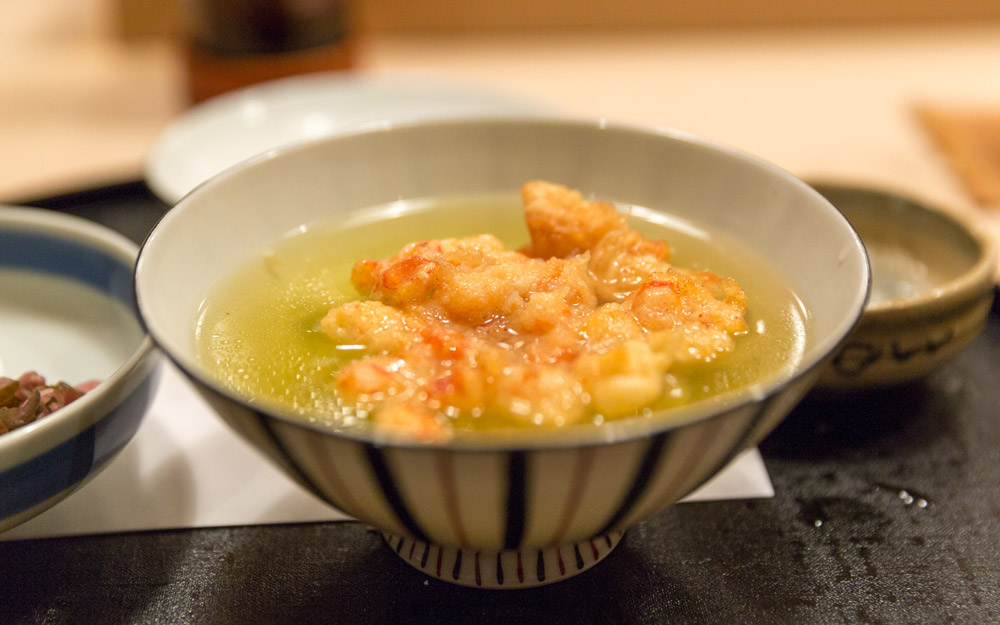
At the end, we got rice. I suppose it's a good way to pack in all that tempura. But because of the bō-age style, nobody felt overstuffed or bloated from excessive oil.
Of course, it wasn't just any rice. We had three choices: tencha 天茶 (rice in tea with tempura), tendon 天丼 (tempura on top of rice with sauce), or kakiage かき揚げ and rice (rice and tempura on a separate dish).
You have the choice between a regular and small portion, but I was getting full so I ordered the small sized tencha… and so did everyone else. For the sake of this article, we probably should have ordered different things, but it just sounded so good.
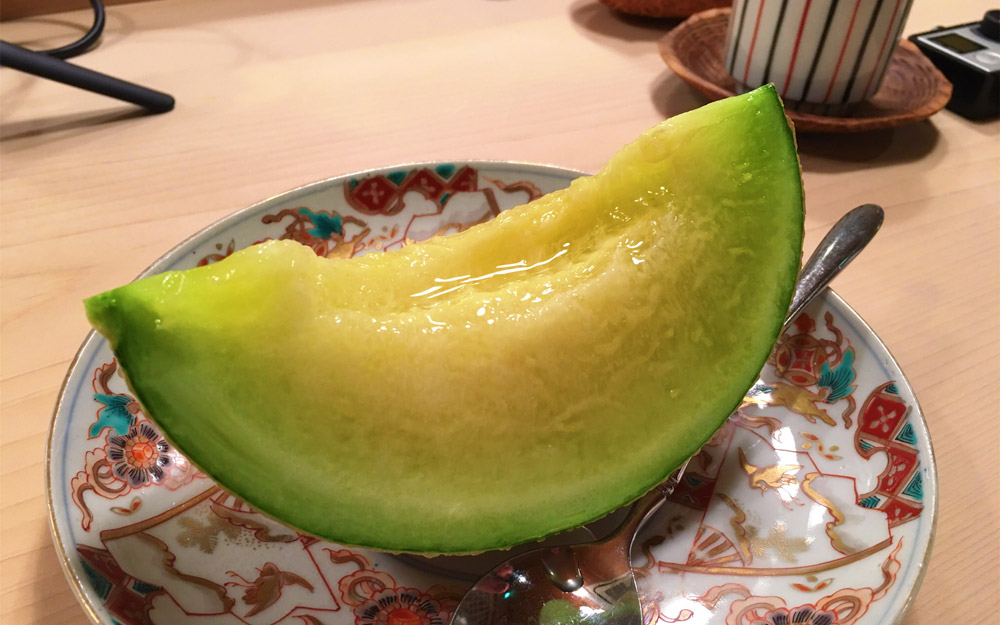
We're not done yet! Dessert came in the form of the Shizuoka melon that won 2016's Agriculture and Forestry Minister Prize. It had such a wonderful smell and was insanely juicy. Like, really. Canadian and American melons are dry by comparison to Japanese melons in general. And now, after eating this melon, I think Japanese melons are dry too. We were all shocked by how good it was. None of us had eaten a melon so juicy or flavorful. For many, this slice of melon was the highlight of the evening.
Chef Sakakibara told us, "Melons are all about the balance of firmness and sweetness. If the balance is off, it's not delicious." This melon was perfect.
Tell Us Your Secrets!
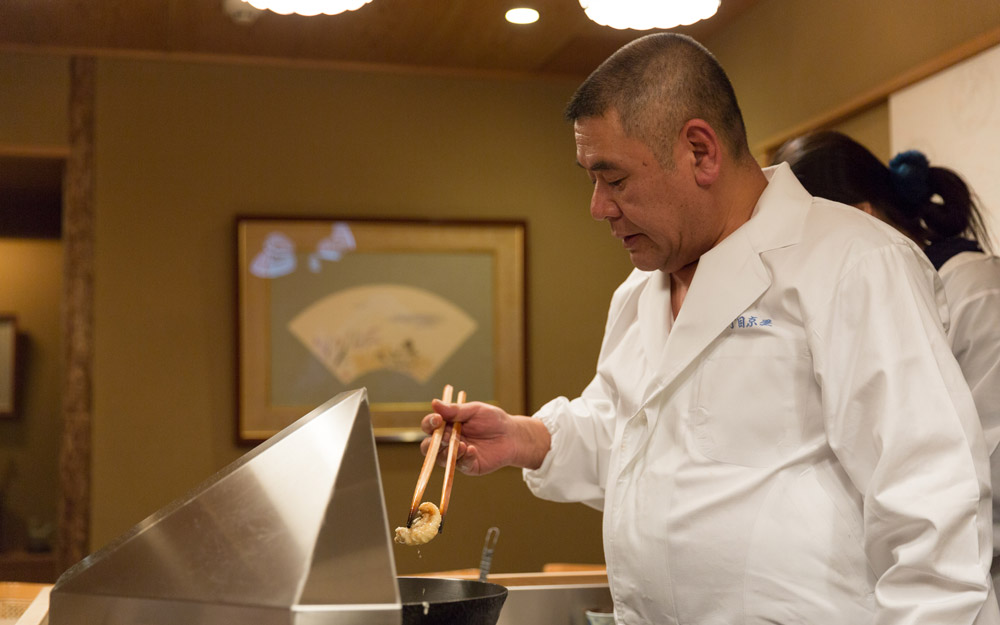
"Our job is to find good ingredients every day and then bring out the best taste that each one of them has within."
—Chef Sakakibara
We had finally finished our meal and it was so good, in every regard. Even the number of dishes was perfect: we were full, but not stuffed. Since it was our last chance, we decided to go for broke and ask the chef, "What's the secret to the deliciousness of your tempura? Why is it so good compared to everything else out there?"
In a humble/secretive way, he answered, "Oh, I don't know. Whether it's delicious or not totally depends on each customer's taste buds. If what the tempura chef serves matches with what the customer likes, they will be a repeat customer. So you can't really say mine is better than other places. Maybe some customers like my tempura, but others might prefer the flavor of a different tempura."
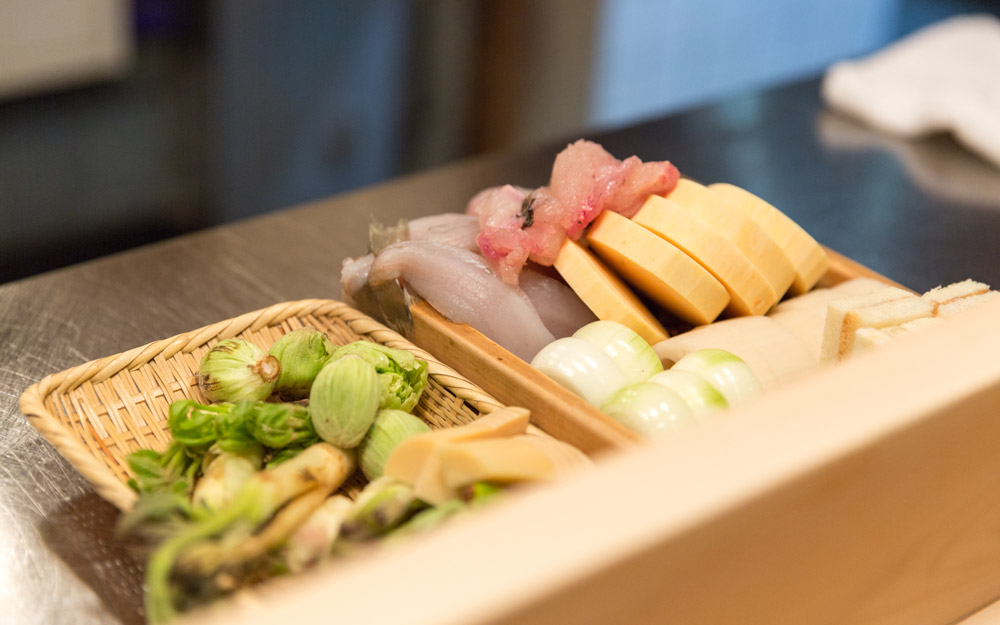
Alas, we were defeated. But he did offer us a small hint which we could build off of. He said, "Japanese cuisine is founded within a culture which focuses on the enjoyment of the natural flavors of any one ingredient. It is tantamount to the food's quality. It's the same with soba, sushi, and so on. If the ingredients aren't good, then it won't be good Japanese food because there is nothing to mask it.
"That's why it's difficult to serve good Japanese food in other countries. Good ingredients change with the seasons. For example, soon I will start deep frying figs. In the fall, I deep-fry chestnuts, blowfish, or pike eel. In the dead of winter, I often make meat tempura because I think it's the best ingredient during that season, even though tempura is not supposed to be made with meat. Our job is to find good ingredients every day and then bring out the best taste that each one of them has within."
Things were getting philosophical. I felt like he could have switched some of those words out with "people" or "humans" and you'd have something deep on your hands.
"I also tend to deep fry unique things that other chefs wouldn't often deep fry, however I don't go out of the mainstream. I don't want to make a display of being unusual or eccentric to bring in customers. I want them to eat delicious ingredients that have been prepared and cooked properly. Serving strange things is simply like a panda bear in a zoo; a unique animal to bring in more people. I don't do such things, like making jokes. If I can, I like to serve customers something new, but ultimately something that I believe would be delicious as tempura. If you do the same thing as everyone else, you tend to just get lost in the batter."
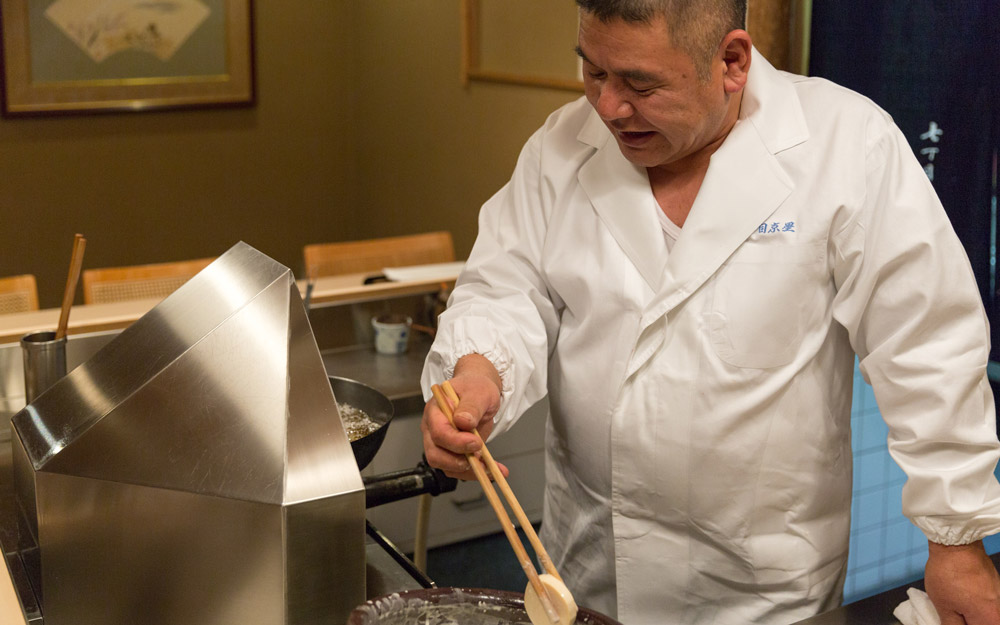
He then concluded his thought with a big smile, "As I said earlier, there is nobody who will take over my technique, so please come here in a different season as many times as you can during my lifetime. A sense of season is important for Japanese food. For example, I serve matsutake mushroom tempura in its season. Just like the most common ways of eating matsutake when it's in season, tempura also turns out to be a delicious way to enjoy them. Even though it's the same seasonal mushroom, it's significantly different from the grilled kind with salt or when you make it in a soup.
"If it's the beginning of the summer, and if I choose fish, Ayu (sweetfish) is delicious. Then, abalone will have its catch ban lifted in June. The shellfish changes to the abalone. In mid-summer, I use hamo (pike conger eel). To enjoy seasonal food like that is the best part of Japanese cuisine. You'll only be able to enjoy certain ones properly by coming at the right time of year."
Although it's expensive, I'm sure all of us felt that we'd like to come back here during a different season, as the head chef Sakakibara suggested. You'll definitely have to consult your wallet, unless you're loaded, but it was our conclusion that this tempura is the best, period. If you're a little worried, I think it's still worth your money and your time. Then, your unease will surely melt like everything else, as soon as the first bite hits your tongue.
Mami’s Review
Although I saw some people had reviewed that the price isn’t quite in line with the value of the cuisine provided, it was absolutely the best tempura I’ve ever had. I was actually surprised that I was so satisfied with their tempura because I’m frugal, so the prices of this place instantly made me super critical to begin with. I don’t know when it will be, but I’d like to try this tempura again someday, like when I win the lottery.
Viet’s Review
I’ve been critical of Japan’s inflated pricing on goods. Nanachōme Kyōboshi has dispelled this criticism. This is legitimately the best tempura I’ve ever had. Little details like the type and texture of the salt, quality of the produce, the oil composition and temperature, how the tempura is handled in the oil, ordering of the course, et cetera is what you are paying for. All these small details add up to an excellent meal. And my god, that melon at the end…
Koichi’s Review
Despite costing nearly $400 a head, I want to go back. If that doesn’t say everything you need to know about a place that’s often criticized for being “too expensive” or “overrated,” I don’t know what will.
Nanachōme Kyōboshi
Additional Information
5 Chome-5-9 Ginza
Chūō, Tokyo 104-0061
Japan
+81 3-3572-3568
